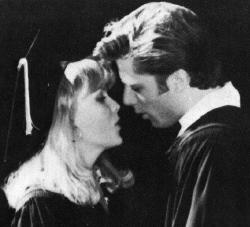 |
based on screenplays by Bronte Woodard and Ken Finkleman Grease and Grease 2
| |

Magnum, London, 1978
|

Sphere, London, 1982
|
|
The blurb on the back:
Grease
Grease 2 The success of Grease was a bit baffling. You could see that the stage show could do well in the mid-1970s - after all, it was another contribution to the 1950s revival that had kicked off with Sha Na Na at Woodstock and the Nader rock & roll shows, and that had made it to Hollywood with American Graffiti and to TV with Happy Days. But by the time Robert Stigwood made the movie in 1978, it looked as anachronistic as its two stars: the 24-year-old John Travolta and the 30-year-old Olivia Newton-John pretending to be high school kids. You see, the whole point of the rock & roll revival had been to restore a sense of balance to a popular culture driven mad by hippie self-indulgence. But then disco came along and punk came along, and the need for a sanitised vision of an idealised age of innocence should surely have receded a little. Well, clearly not, because Grease was an enormous success. Not just the film itself, but the music from the film - two singles reached #1 in Britain, with 'Sandy' just tailing them at #2 and Frankie Valli's 'Grease' at #3. The main theme from Grease 2, on the other hand, was 'Back To School Again' by the Four Tops. Which peaked at #62. And the same was pretty much true of the film, which missed out on getting an audience. One interpretation of this failure might be that the nostalgia trip was finally coming to an end, but there were other factors. Principal amongst them was the delay in releasing the sequel - four years after the first film, which is like a generation when you're a kid. Also relevant was the fact that there were very few lines of continuity between the two (Frenchy survived, but then who ever cared about Frenchy?), and that Maxwell Caulfield, later to play Miles Colby in The Colbys, was no John Travolta. BUT - and this is a desperately important but - the huge benefit of Grease 2 was that we lost Olivia Newton-Squirrel in favour of the glorious Michelle Pfeiffer. Now that's what I call trading up to a better model. Fresh from her triumph in Charlie Chan and the Curse of the Dragon Queen (Peter Ustinov and Angie Dickinson in the title roles), Pfeiffer appeared here in a starring capacity for the first time. And she was genuinely good. Far better than the film deserved, to be honest. It may be the hindsight talking (and, believe me, I can talk the hindsight off a donkey) but she looked like a star even then. Not, however, to the publishers of the novelization. The eight pages of photographs feature far too few shots of 'Chelle; we could have happily lost the full-page of Nogerelli and Pauline (Adrian Zmed and Lorna Luft), and got in a portrait of Our Heroine unsullied by the presence of Caulfield. The novels? Don't be silly. Neither is any good. Not much to say really. Save to mention that I originally queried whether this is the same William Rotsler who used to knock out Star Trek fiction. Ian Covell, a correspondent who frequently fills in the gaps in my knowledge, confirms that indeed it is, and that Mr Rotsler (sometimes known as Bill Rotsler) also wrote novelizations of Mr Merlin, Vice Squad, Futureworld, Return to the Planet of the Apes, The A Team, Sinbad and the Eye of the Tiger, The Goonies, Iron Man and It's Your Move. Busy man.  Pfeiffer & Caulfield ENTERTAINMENT VALUE: 2/5 HIPNESS QUOTIENT: 3/5
 
 Can's Stop The Music home | ||